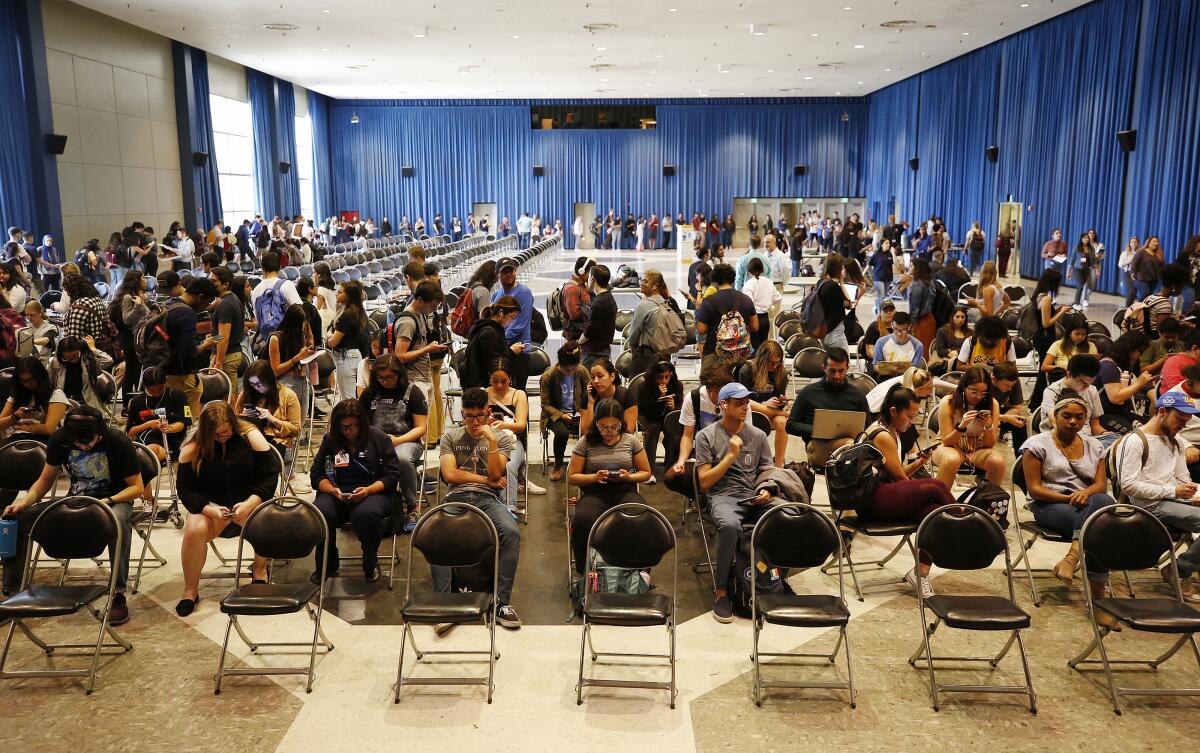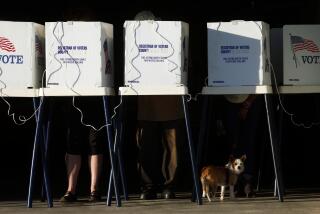California officials demand changes to L.A. voting after election day chaos

SACRAMENTO — California’s chief elections officer lashed out Thursday at the series of election day mishaps in Los Angeles County, demanding that local officials mail ballots to each of the county’s 5.5 million voters for the November election.
“I’m beyond frustrated and disappointed in what I saw on Tuesday, and I’m committed to making sure it doesn’t happen again,” Secretary of State Alex Padilla said. “Clearly, voters deserve better.”
L.A. County’s rollout of its long-awaited voting system — including new ballot-marking machines and regional vote centers used in lieu of neighborhood polling places — was marred by reports of broken devices and wait times of three hours or longer. Many of the voters standing in long lines were angry that they had no other way to cast a ballot in the statewide presidential primary. Los Angeles County was given special treatment under a 2016 state election law, allowing officials to close polling places without mailing a ballot to every voter.
That provision will expire in 2024. But for Tuesday’s election, it meant that as many as 2 million Angelenos were forced to find one of the vote centers, of which there were far fewer than polling places used in the 2018 election.
“L.A. County appealed to the Legislature for special treatment and they got it,” said Padilla, a former state senator and president of the L.A. City Council.
Perhaps no California county had more at stake in the statewide primary this year than Los Angeles, home to more voters than anywhere else in the state, and whose officials attempted to implement the new law while also rolling out a new $300-million system for marking and counting ballots. Images of voters standing in long lines deep into the night on Tuesday were seen across the nation, and voters complained of problems on social media and by calling the state’s election hotline.
State Sen. Ben Allen (D-Santa Monica), the author of the 2016 law to move counties away from traditional elections and toward a model that combines absentee ballots with full-service centers for those who want to vote in person, said he will introduce legislation next week that would require L.A. County to open more vote centers in November or mail all registered voters a ballot.
“I regret not having pushed harder on L.A. County last time around,” Allen said of the negotiations over his law, the Voter’s Choice Act. “And I’m trying to fix things with this bill.”
For those voters who received ballots, the process didn’t always go smoothly, either. About 17,000 ballots arrived late to voters in areas including Lancaster, Sunland-Tujunga and other pockets of the county, said L.A. County Registrar/Recorder spokesman Mike Sanchez. He said the vendor hired by the county told the elections division last week that it had failed to send some vote-by-mail ballots that should have been mailed by early February. After realizing the error, the vendor sent the ballots by first-class mail on Feb. 26.
Lancaster Mayor R. Rex Parris said he never received his vote-by-mail ballot, so he voted in person.
“I think it was legitimate incompetence,” he said. “I don’t think it was something nefarious.”
However, Parris said that the widespread voting problems reported on Tuesday won’t inspire confidence in those who are already discouraged about California’s political system.
“People have lost confidence, people feel disenfranchised,” Parris said. “The best way to increase malaise is to make people feel like you’re manipulating the election.”
The exact number of ballots cast in L.A. County remains unknown, either through the mail or at one of the 978 vote centers. Fewer than 500,000 of the ballots cast in person on election day had been tallied as of Thursday afternoon. While many of the vote centers were open 10 days prior to election day, relatively few L.A. voters cast ballots during that time — a lackluster response that foreshadowed the rush of people on election day.
The state’s Voter’s Choice Act, so far adopted by 15 of California’s 58 counties, counts on voters changing their behavior in one of two ways: voting early or by mail. It’s a choice that was available to every voter in every county but Los Angeles.
At the time of the law’s passage, county officials argued that they didn’t have the capacity to mail everyone a ballot. The special provision was not included in the first drafts of the legislation, Senate Bill 450, but was added without fanfare during the legislative process.
“They said it wasn’t logistically feasible,” Allen said of the discussions. “They said it was too expensive.”
Padilla, who was the new law’s most vocal champion and raised no concerns in 2016 about exempting L.A. from mailing everyone a ballot, insisted Thursday it was not his decision.
“It was a mistake for the Legislature to give L.A. County special treatment,” he said.
Dean Logan, L.A. County’s registrar of voters, said in a written statement he released Thursday that Padilla’s call to mail everyone a ballot would not be easy.
“The logistics and capacity for election administration in Los Angeles County are complex and demanding,” Logan wrote. “Significant efforts were made — and must be made going forward — to ensure greater access, functionality and reliability in the voting model. Expansion of vote by mail should be explored to determine its viability in the short timeframe ahead of the November election, but more is required.”
On Wednesday, L.A. County supervisors signaled that they would ask for an investigtion into the root causes of the problems, though some supervisors believed a key factor was that so many voters waited to cast ballots until election day. Others have pointed out the variety of changes made to the voting experience at the same time — some failed to perform as expected, including tablet devices used to check a voter’s registration upon arrival at a vote center that were often slow or unable to make an online connection.
Richard L. Hasen, an election law professor at UC Irvine, said that the novelty of the new voting machines and check-in tablets made enhanced training important. And he said an influx of younger, more technologically savvy election workers would help.
“The technology has gone from fourth-grade technology to graduate school-level technology,” he said. “You need younger people who are more comfortable with the technology. There should be a big push for that.”
More to Read
Sign up for Essential California
The most important California stories and recommendations in your inbox every morning.
You may occasionally receive promotional content from the Los Angeles Times.













